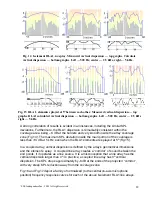
' SLS loudspeakers Inc., 2002. All rights reserved.
2
inside the enclosure behind the high frequency section. Some use a straightforward
horizontal separation. Yet other designs put them in the walls of high frequency horn flare
behind narrow slots. One compromise leads to another. As a result, these line arrays
exhibit little or no resemblance to a truly coherent line source system.
In reality, none of the line array systems which use midrange and high frequency drivers,
loaded with complex multistage wave-shaping devices can deliver high fidelity sound and
consistent coverage. Very few actually perform satisfactorily. In spite of fierce marketing
battles about who’s line array design approach is better, the principle compromise
common to all of them remains the same, - reshaping of the original sound wavefront
through essentially non-linear devices.
While other systems inevitably embrace a design which is a poor approximation of a
planar line source, the RLA 1 ribbon line array system from SLS directly uses unique
planar ribbon drivers (PRD 1000) which allow for nearly prefect implementation of the line
source concept, proving to be the only technically feasible solution for high fidelity line
array technology.
During the research and development stage of the RLA 1 design, it was recognized that
there is a need for a computer program which would provide an accurate prediction of line
array dispersion. The few existing “in-house” programs are either based on an
oversimplified approach that limits their usefulness, and/or do not allow for simulation of
the very essential near field and transition regions of a line array, but rather describe its
performance based on a far field model used for common point source systems.
Recognizing this need, SLS Loudspeakers developed the LASS Line Array Simulator
Software program. It is an accurate software tool, which allows for simulation of line array
dispersion and prediction of sound field parameters throughout the venue. LASS has
been used in this paper to produce images and results for the demonstration of line array
principles.
Basics of a line array system and its benefits
A line array system concept is derived from line source theory.
An ideal line source is an infinite, thin (narrow) and continuous vibrating element which
radiates cylindrical waves. Such a line source has a remarkable radiation property, - its
SPL level decreases inversely proportionately to the distance from the source, losing only
3dB with each doubling of the distance. A point source radiator (common loudspeakers
are considered to be point source radiators) generates a spherical wave. Its SLP
decreases inversely proportionately to the square of the distance from the source, losing
6 dB with each doubling of the distance.
This phenomenon can be understood, considering that expansion of a cylindrical
wavefront results in a surface area gain being proportionate to increasing distance, while
expansion of a spherical wavefront produces an area gain, which is proportionate to the
square of the distance.
Unlike the infinite ideal line radiator, a line source with limited length has limited extension
of its cylindrical wavefront zone (near field). Beyond a certain distance, the cylindrical
wavefront gradually transforms into the spherical wavefront (far field) and the system


































